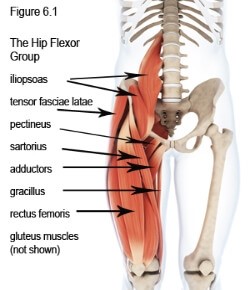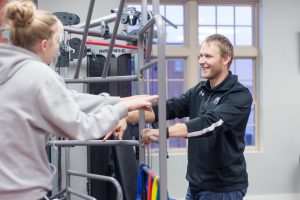Tight Hip Flexors: How to Diagnose Yourself
by Dr. Troy Vander Molen, PT, DPT
Has modern technology impacted the way you spend your time each day either at home or work? No one questions the positive impacts the advancement of technology has on our world, but with these advancements also comes some consequences. For those of you who find yourselves sitting more behind a desk or while driving a vehicle or machine, you may also find yourself suffering the results of tight hip flexor muscles.
 What are your hip flexor muscles?
What are your hip flexor muscles?
The primary hip flexor muscle is called the iliapsoas, a muscle that is made up of two parts. The iliacus portion originates from the pelvis, and the psoas originates from the lower lumbar spine. They both connect onto the front of the upper femur.
Another muscle that is part of the hip flexor group is the rectus femoris, which is one of the four quadriceps muscles, the only part of the quadriceps that crosses the hip joint.
Why are tight hip flexors a problem?
If you’ve read my articles over the past few years, you know that issues at one area tend to have consequences at neighboring areas. In this case, tightness of the hip flexor group can be a root problem that contributes to lower back pain because of the impact that tightness has on the position of the pelvis and spine. If these muscles are tight, the pelvis tends to lean forward and the lumbar spine may increase its inward curve when you move from sitting to a standing position. In other words, your back pain may really be a tight hip flexor issue.
 How do I know if I have tight hip flexors?
How do I know if I have tight hip flexors?
It is important to note that though many people may feel like they have tight hip flexors, there may be other reasons for that sensation. It is important to determine if you have tight hip flexors before you start to work on hip flexor mobility. You can do this with a simple screen called the Thomas Test.
To test yourself, sit on the edge of a firm table or your bed and lie back. Pull one knee firmly to your chest, and let the other leg lower. The goal is to get the upper leg to fall parallel to the ground while bending that knee to 90 degrees. If you can accomplish this on both sides, you do not have tight hip flexors.
If your knee bends 90 degrees but the upper leg is unable to lay parallel to the ground, you likely have tightness in the iliapsoas muscle group. If your leg lays parallel to the ground but your knee cannot bend 90 degrees, you likely have tightness in the rectus femoris muscle. One other important note: if you can do both but your upper leg moves laterally, you may have tightness in another small but important muscle on the lateral hip, the TFL.
My Thomas Test is normal. So, why does my hip flexor feel tight?
Because the iliapsoas muscle originates from the lumbar spine and pelvis, they are involved in stabilizing the lower back. If you are lacking in core stability, these muscles may demonstrate some increased muscle tone. If that’s the case, it will do no good to stretch the hip flexors. Instead, you need a core stabilization program that will eventually help reduce hip flexor muscle tone.
What do I do about my tight hip flexors?
 There are a variety of beneficial stretches that can work wonders for tight hip flexors. And this is important because it just might be the key to unlocking the solution to your lower back pain problem. The key is doing the correct exercise for your specific need.
There are a variety of beneficial stretches that can work wonders for tight hip flexors. And this is important because it just might be the key to unlocking the solution to your lower back pain problem. The key is doing the correct exercise for your specific need.
If you would like to understand which exercises will be most effective for your specific issue, contact us at 866-588-0230 to schedule a free 20-minute hip flexor screen. We have 10 slots available at each of our clinics this month, so call today to reserve your spot.



